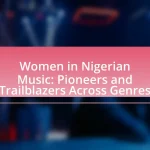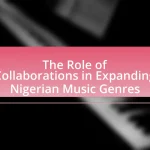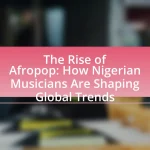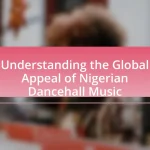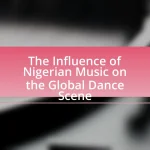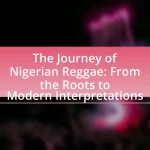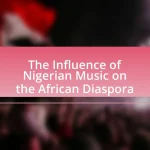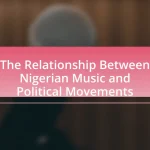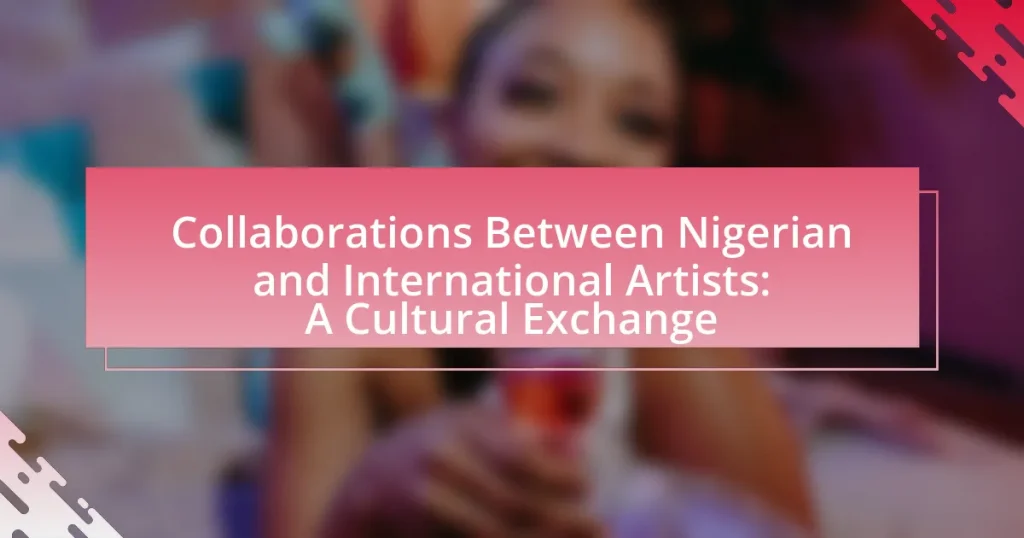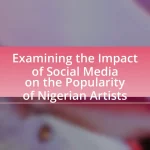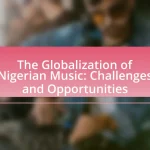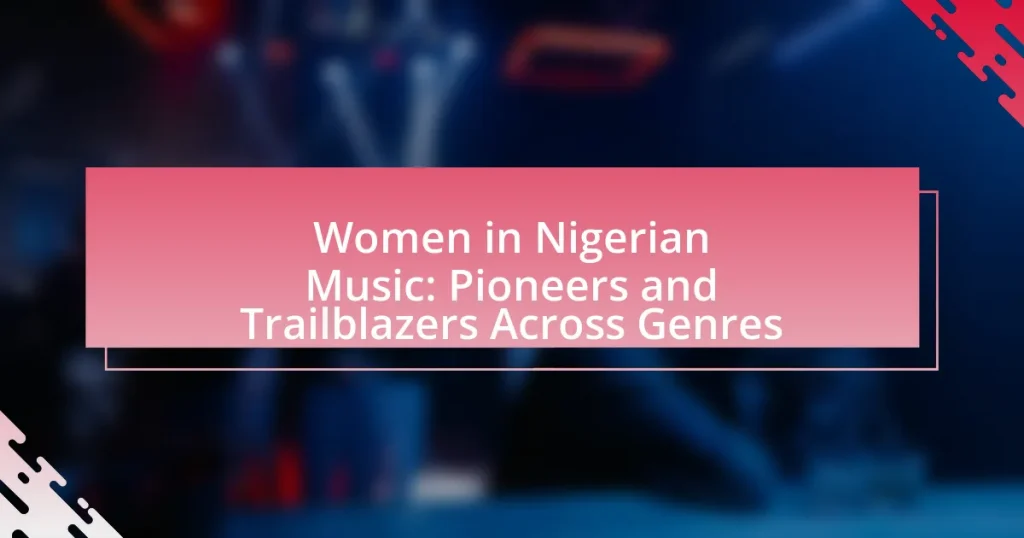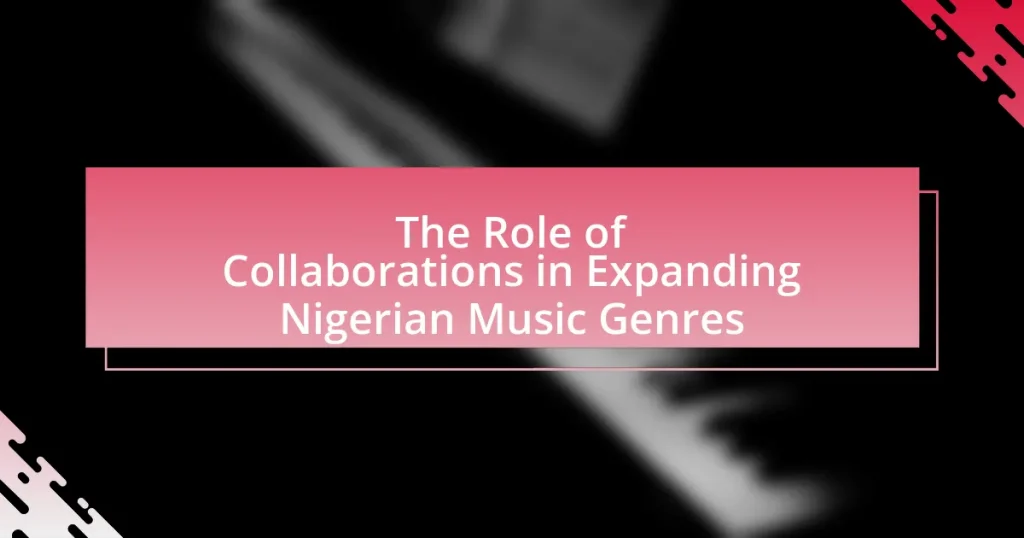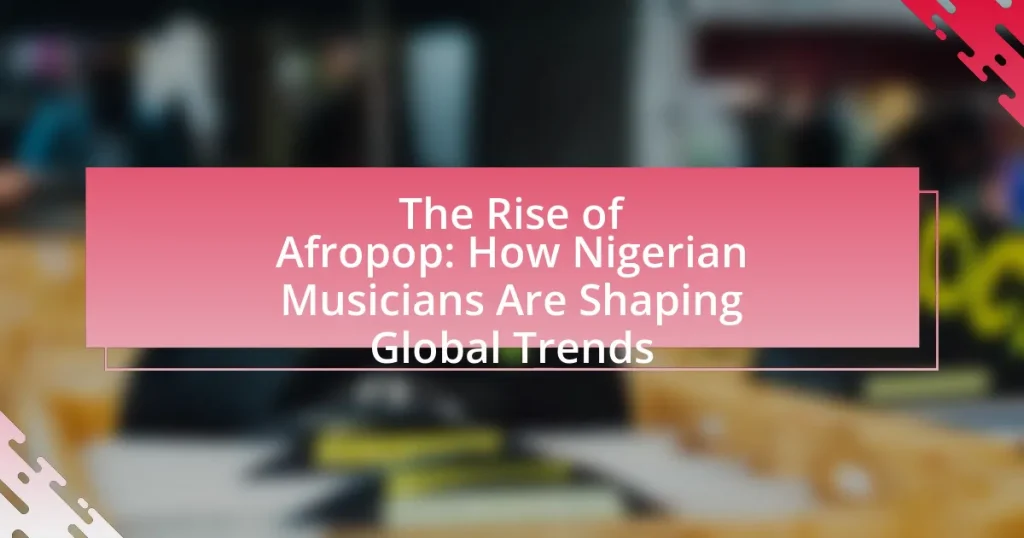Collaborations between Nigerian and international artists represent a significant cultural exchange that blends diverse musical styles and artistic expressions. These partnerships enhance the visibility of Nigerian music globally, as seen in successful collaborations involving artists like Burna Boy and Wizkid with international stars such as Ed Sheeran and Drake. The article explores the historical context of these collaborations, their impact on cultural identities, and the various artistic mediums involved. It also addresses the challenges faced during these partnerships and highlights notable examples that have shaped the careers of the artists involved, ultimately promoting Nigerian culture on the international stage.
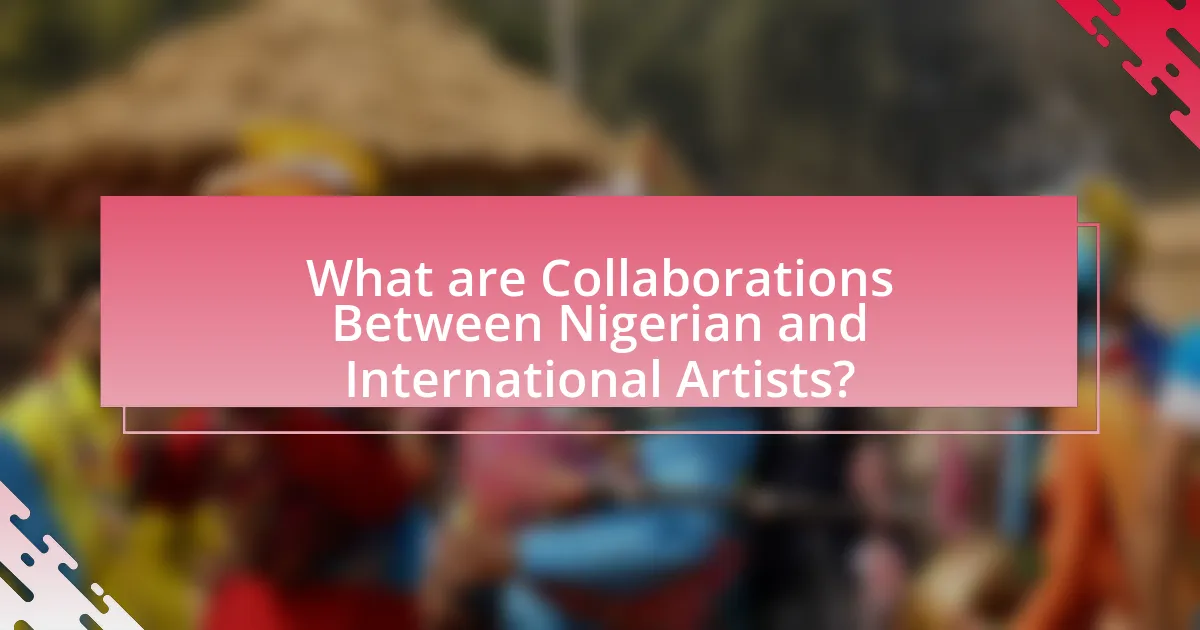
What are Collaborations Between Nigerian and International Artists?
Collaborations between Nigerian and international artists involve joint creative projects that blend diverse musical styles, cultural influences, and artistic expressions. These partnerships often result in unique works that showcase the richness of Nigerian culture while incorporating global elements. For instance, Nigerian artists like Burna Boy and Wizkid have collaborated with international stars such as Ed Sheeran and Drake, leading to chart-topping hits that resonate with audiences worldwide. Such collaborations not only enhance the visibility of Nigerian music on the global stage but also foster cultural exchange, allowing for the sharing of ideas and artistic techniques across borders.
How do these collaborations foster cultural exchange?
Collaborations between Nigerian and international artists foster cultural exchange by blending diverse artistic traditions and perspectives, which enhances mutual understanding and appreciation. These partnerships often result in the creation of hybrid art forms that reflect both Nigerian cultural elements and international influences, thereby broadening the audience’s exposure to different cultures. For instance, projects like the collaboration between Nigerian musician Burna Boy and American artist Beyoncé on the “Lion King: The Gift” album showcase how cross-cultural collaborations can introduce African sounds to global platforms, promoting cultural dialogue and awareness.
What are the historical contexts of these collaborations?
Collaborations between Nigerian and international artists have historical contexts rooted in the globalization of music and art, particularly from the late 20th century onward. The rise of genres like Afrobeat, pioneered by Fela Kuti in the 1960s, laid the groundwork for cross-cultural partnerships, as it blended traditional African rhythms with jazz and funk, attracting global attention. Additionally, the Nigerian civil war (1967-1970) and subsequent diaspora led to a cultural exchange that influenced both local and international artists, fostering collaborations that highlighted social issues and cultural narratives. The 1990s saw increased interest in African music, with artists like Angelique Kidjo collaborating with Western musicians, further solidifying these partnerships. The advent of digital technology in the 2000s facilitated easier communication and collaboration across borders, allowing Nigerian artists to engage with global platforms and audiences, exemplified by collaborations such as Wizkid with Drake and Burna Boy with Ed Sheeran. These historical contexts illustrate a dynamic interplay of cultural exchange that has evolved over decades, shaping the contemporary music landscape.
How do collaborations reflect the cultural identities of the artists involved?
Collaborations between Nigerian and international artists reflect the cultural identities of the artists involved by blending distinct musical styles, languages, and cultural narratives. For instance, when Nigerian Afrobeat artists collaborate with Western musicians, they often incorporate traditional rhythms and local dialects, showcasing their heritage while also adapting to global music trends. This fusion not only highlights the artists’ cultural backgrounds but also creates a dialogue between different cultural expressions, as seen in the collaboration between Burna Boy and Ed Sheeran on the song “Own It,” which merges Afrobeat with pop elements. Such partnerships serve as a platform for cultural exchange, allowing artists to share their unique identities while reaching broader audiences.
What types of collaborations exist between Nigerian and international artists?
Collaborations between Nigerian and international artists primarily include musical partnerships, joint performances, and cross-genre projects. Musical partnerships often involve Nigerian artists featuring international musicians on tracks, which enhances global reach; for example, Wizkid’s collaboration with Drake on “One Dance” significantly boosted his international profile. Joint performances, such as festivals where both Nigerian and international artists share the stage, foster cultural exchange and audience engagement, exemplified by events like the Afro Nation festival. Cross-genre projects, where Nigerian artists blend traditional sounds with international music styles, create innovative works that appeal to diverse audiences, as seen in Burna Boy’s fusion of Afrobeat with reggae and dancehall influences. These collaborations not only enrich the artists’ creative expressions but also promote cultural dialogue on a global scale.
What are the different artistic mediums involved in these collaborations?
The different artistic mediums involved in collaborations between Nigerian and international artists include visual arts, music, dance, theater, and literature. Visual arts often encompass painting, sculpture, and installation, showcasing cultural narratives and aesthetics. Music collaborations frequently blend traditional Nigerian sounds with global genres, creating innovative fusions. Dance serves as a dynamic medium for expressing cultural stories and movements, while theater combines performance art with storytelling, often addressing social issues. Literature, including poetry and prose, facilitates cross-cultural dialogue and exchange of ideas. These mediums collectively enhance the richness of cultural exchange and foster mutual understanding.
How do collaborations vary across genres and styles?
Collaborations vary across genres and styles primarily in their thematic focus, musical elements, and cultural influences. For instance, in hip-hop, collaborations often emphasize lyrical storytelling and rhythmic complexity, while in pop, they may prioritize catchy melodies and broad appeal. Additionally, genres like Afrobeats incorporate traditional African rhythms and instruments, creating a unique fusion when collaborating with international artists, as seen in the partnership between Burna Boy and Ed Sheeran. This blending of styles not only enhances the musical experience but also promotes cultural exchange, allowing artists to reach diverse audiences and share their heritage.
What impact do these collaborations have on the global music and art scene?
Collaborations between Nigerian and international artists significantly enhance the global music and art scene by fostering cultural exchange and innovation. These partnerships introduce diverse musical styles and artistic expressions, leading to the creation of hybrid genres that appeal to a broader audience. For instance, the collaboration between Nigerian Afrobeats artists and Western pop musicians has resulted in chart-topping hits that blend traditional African rhythms with contemporary sounds, exemplified by the success of artists like Burna Boy and Wizkid on global platforms such as Billboard. This cross-pollination not only enriches the artistic landscape but also promotes greater visibility and appreciation of African culture worldwide, as evidenced by the increasing number of international music festivals featuring African artists.
How do they influence trends in the music industry?
Collaborations between Nigerian and international artists significantly influence trends in the music industry by blending diverse musical styles and expanding audience reach. These partnerships often result in innovative sounds that attract listeners from various cultural backgrounds, thereby shaping contemporary music trends. For instance, the collaboration between Nigerian artist Wizkid and American artist Drake on the track “One Dance” not only topped charts globally but also popularized Afrobeat in mainstream music, demonstrating how such collaborations can elevate genres and create new market dynamics.
What role do collaborations play in promoting Nigerian culture internationally?
Collaborations play a crucial role in promoting Nigerian culture internationally by facilitating cultural exchange and enhancing visibility. When Nigerian artists collaborate with international counterparts, they create a fusion of styles that showcases the richness of Nigerian traditions, music, and art to a global audience. For instance, the collaboration between Nigerian artist Burna Boy and American musician Beyoncé on the song “Ja Ara E” introduced Afrobeat to a wider audience, significantly increasing interest in Nigerian music. Such partnerships not only elevate the profiles of Nigerian artists but also foster appreciation for the cultural narratives and heritage of Nigeria, as evidenced by the growing number of international festivals featuring Nigerian performances and art exhibitions.
How do Nigerian artists benefit from international collaborations?
Nigerian artists benefit from international collaborations by gaining exposure to global audiences and enhancing their artistic credibility. These collaborations often lead to increased visibility in international markets, allowing Nigerian artists to reach fans beyond their local context. For instance, partnerships with well-known international artists can result in higher streaming numbers and sales, as seen with Nigerian musicians like Burna Boy and Wizkid, who have collaborated with global stars such as Beyoncé and Drake. Such collaborations not only elevate their profiles but also contribute to the growth of the Nigerian music industry on a global scale, evidenced by the rise of Afrobeats as a dominant genre in international music charts.
What opportunities for exposure do these collaborations create?
Collaborations between Nigerian and international artists create significant opportunities for exposure by broadening audiences and enhancing cultural visibility. These partnerships allow Nigerian artists to showcase their work on global platforms, reaching diverse demographics that may not have been accessible otherwise. For instance, collaborations often lead to joint exhibitions, performances, and digital content that can be shared across various media channels, increasing the artists’ recognition and marketability. Additionally, such collaborations can result in cross-cultural exchanges that enrich the artistic landscape, as evidenced by projects like the “Afrobeats to the World” initiative, which has successfully introduced Nigerian music to international markets, thereby expanding the reach and influence of participating artists.
How do they contribute to the professional growth of Nigerian artists?
Collaborations between Nigerian and international artists significantly contribute to the professional growth of Nigerian artists by providing exposure to global markets and diverse artistic practices. These partnerships enable Nigerian artists to showcase their work on international platforms, thereby increasing their visibility and potential for commercial success. For instance, collaborations often lead to participation in international art fairs and exhibitions, which can result in sales and networking opportunities that would otherwise be inaccessible. Additionally, working alongside international artists allows Nigerian artists to learn new techniques and gain insights into different cultural perspectives, enhancing their creative skills and broadening their artistic horizons. This exchange of ideas and practices fosters innovation and can lead to the development of unique art forms that resonate both locally and globally.
What challenges do Nigerian and international artists face in collaborations?
Nigerian and international artists face several challenges in collaborations, primarily including cultural differences, logistical issues, and financial constraints. Cultural differences can lead to misunderstandings in artistic vision and communication styles, impacting the collaborative process. Logistical issues often arise from varying time zones, travel restrictions, and differing production standards, complicating project timelines. Financial constraints can limit access to resources, as many Nigerian artists may struggle with funding compared to their international counterparts, affecting the scale and quality of collaborative projects. These challenges highlight the complexities of cross-cultural artistic partnerships.
How do cultural differences impact the collaboration process?
Cultural differences significantly impact the collaboration process by influencing communication styles, decision-making approaches, and conflict resolution strategies. For instance, in collaborations between Nigerian and international artists, Nigerian culture often emphasizes collectivism and relationship-building, which can lead to a more communal approach to decision-making. In contrast, many Western cultures prioritize individualism and direct communication, potentially causing misunderstandings. Research by Hofstede’s cultural dimensions theory indicates that these differences can lead to varying expectations and interpretations of collaboration, affecting overall project outcomes. Therefore, recognizing and addressing these cultural nuances is essential for successful collaboration.
What logistical issues arise during these collaborations?
Logistical issues that arise during collaborations between Nigerian and international artists include communication barriers, scheduling conflicts, and resource allocation challenges. Communication barriers often stem from differences in language and cultural nuances, which can lead to misunderstandings and misalignment of project goals. Scheduling conflicts arise due to time zone differences and varying work schedules, making it difficult to coordinate meetings and collaborative sessions. Resource allocation challenges involve the distribution of funds, equipment, and personnel, which can be complicated by differing financial systems and availability of resources in Nigeria compared to international standards. These factors can hinder the smooth execution of collaborative projects and impact overall success.
What are some notable examples of successful collaborations?
Notable examples of successful collaborations between Nigerian and international artists include the partnership between Wizkid and Drake on the song “One Dance,” which topped charts globally and showcased the fusion of Afrobeats with mainstream pop. Another significant collaboration is Burna Boy’s feature on Beyoncé’s “Brown Skin Girl,” which received critical acclaim and highlighted African culture on an international platform. Additionally, the collaboration between Tiwa Savage and American artist Omarion on “Get It Now” exemplifies the blending of musical styles and cultural exchange. These collaborations not only achieved commercial success but also contributed to the global recognition of Nigerian music.
How have these collaborations shaped the careers of the artists involved?
Collaborations between Nigerian and international artists have significantly enhanced the careers of the involved artists by expanding their reach and diversifying their musical styles. For instance, Nigerian artists like Burna Boy and Wizkid gained global recognition through collaborations with international stars such as Beyoncé and Drake, respectively. These partnerships not only introduced their music to wider audiences but also led to increased streaming numbers and chart success, exemplified by Burna Boy’s Grammy nomination for “African Giant” and Wizkid’s “Essence” becoming a global hit. Such collaborations have also facilitated cultural exchange, allowing artists to blend genres and innovate, which further solidifies their positions in the global music industry.
What lessons can be learned from these successful partnerships?
Successful partnerships between Nigerian and international artists demonstrate the importance of cultural exchange, mutual respect, and collaboration. These partnerships highlight that blending diverse artistic perspectives can lead to innovative creations that resonate with broader audiences. For instance, collaborations often result in unique musical fusions, as seen in the global popularity of Afrobeat, which combines traditional Nigerian music with various international genres. This cross-cultural synergy not only enhances artistic expression but also fosters understanding and appreciation of different cultures, ultimately enriching the global arts landscape.
What best practices can artists follow for successful collaborations?
Artists can follow several best practices for successful collaborations, including clear communication, mutual respect, and defined roles. Clear communication ensures that all parties understand the project goals and expectations, which minimizes misunderstandings. Mutual respect fosters a positive working environment, allowing artists to value each other’s contributions and perspectives. Defined roles clarify responsibilities, helping to streamline the creative process and avoid conflicts. Research indicates that successful collaborations often result from these practices, as they enhance teamwork and creativity, leading to more impactful artistic outcomes.
